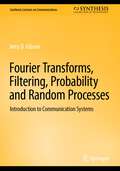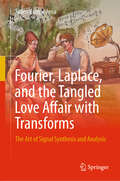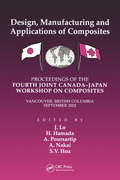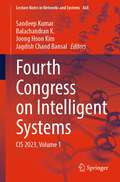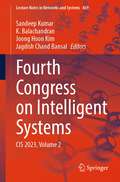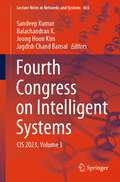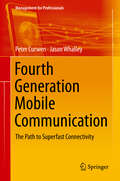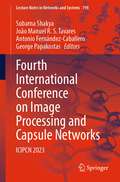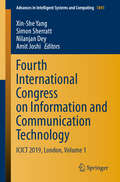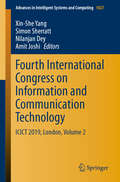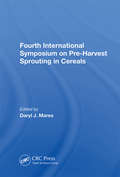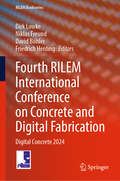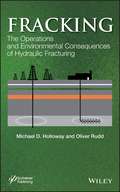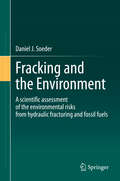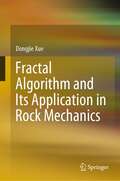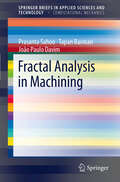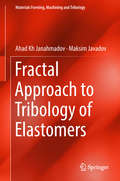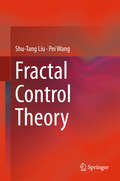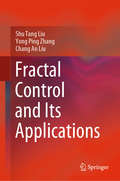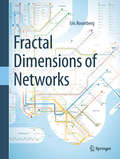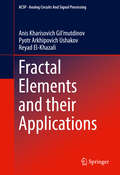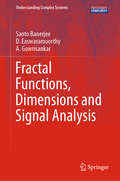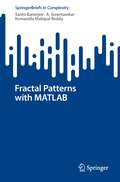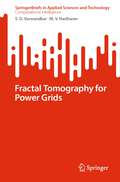- Table View
- List View
Fourier Transforms, Filtering, Probability and Random Processes: Introduction to Communication Systems (Synthesis Lectures on Communications)
by Jerry D. GibsonThis book provides backgrounds and the mathematical methods necessary to understand the basic transforms in signal processing and linear systems to prepare for in depth study of analog and digital communications systems.This tutorial presentation provides developments of Fourier series and other orthogonal series, including trigonometric and complex exponential Fourier series, least squares approximations and generalized Fourier series, and the spectral content of periodic signals. This text thoroughly covers Fourier transform pairs for continuous time signals, Fourier transform properties, and the magnitude and phase of Fourier transforms. The author includes discussions of techniques for the analysis of continuous time linear systems in the time and frequency domains with particular emphasis on the system transfer function, impulse response, system/filter bandwidth, power and energy calculations, and the time domain sampling theorem.
Fourier, Laplace, and the Tangled Love Affair with Transforms: The Art of Signal Synthesis and Analysis
by Sofen Kumar JenaUnlock the intricate language of signals and systems with this in-depth exploration of Fourier and Laplace transforms. Designed for advanced undergraduates, graduate students, and professionals in engineering, physics, and applied mathematics, this book unravels the foundations of signal processing with a rigorous yet engaging approach. Beginning with the fundamentals and building to advanced topics, each chapter guides you through the Fourier series, Fourier, and Laplace transform and into the realms of discrete Fourier and Z transforms, multi-dimensional analysis, and applications of the Fourier Transform in solving PDE, ODE, and Integral equations. The text brings mathematical theory to life through real-world applications in signal synthesis, systems engineering, and differential equations, making complex topics accessible and inspiring. With its unique blend of historical insights, practical applications, and intuitive explanations, this book offers a comprehensive yet approachable journey into the world of transforms. Whether you're a student building your foundation or a professional seeking to deepen your expertise, this book invites you to discover the elegance and utility of transforms in a way that bridges theory with the demands of modern engineering and science.
Fourth Canada-Japan Workshop on Composites: Proceedings Of The Fifth Joint Canada-japan Workshops On Composites
by Suong V. HoaWhile this proceedings volume deals primarily with the conventional areas of metal, ceramic, and polymer composites for civil construction, several of the papers report on new developments in the emerging fields of wood and nanocomposites. The 63 papers from the September 2002 workshop includes the further integration of the fabrication and function processes, aspects of the scale of components which improve the competitive position of composites relative to conventional materials and the exploitation of new types of composite such as nanocomposites which exploit a variety of new length scales to achieve their functionality. This also gives rise to multifunctional composites which have attributes other than structural properties. In this talk these aspects of the future of composites will be explored and illustrated.
Fourth Congress on Intelligent Systems: CIS 2023, Volume 1 (Lecture Notes in Networks and Systems #868)
by Sandeep Kumar Jagdish Chand Bansal Joong Hoon Kim Balachandran K.This book is a collection of selected papers presented at the Fourth Congress on Intelligent Systems (CIS 2023), organized by CHRIST (Deemed to be University), Bangalore, India, under the technical sponsorship of the Soft Computing Research Society, India, during September 4–5, 2023. It includes novel and innovative work from experts, practitioners, scientists, and decision-makers from academia and industry. It covers topics such as the Internet of Things, information security, embedded systems, real-time systems, cloud computing, big data analysis, quantum computing, automation systems, bio-inspired intelligence, cognitive systems, cyber-physical systems, data analytics, data/web mining, data science, intelligence for security, intelligent decision-making systems, intelligent information processing, intelligent transportation, artificial intelligence for machine vision, imaging sensors technology, image segmentation, convolutional neural network, image/video classification, soft computing for machine vision, pattern recognition, human-computer interaction, robotic devices and systems, autonomous vehicles, intelligent control systems, human motor control, game playing, evolutionary algorithms, swarm optimization, neural network, deep learning, supervised learning, unsupervised learning, fuzzy logic, rough sets, computational optimization, and neuro-fuzzy systems.
Fourth Congress on Intelligent Systems: CIS 2023, Volume 2 (Lecture Notes in Networks and Systems #869)
by K. Balachandran Sandeep Kumar Jagdish Chand Bansal Joong Hoon KimThis book is a collection of selected papers presented at the Fourth Congress on Intelligent Systems (CIS 2023), organized by CHRIST (Deemed to be University), Bangalore, India, under the technical sponsorship of the Soft Computing Research Society, India, during September 4–5, 2023. It includes novel and innovative work from experts, practitioners, scientists, and decision-makers from academia and industry. It covers topics such as the Internet of Things, information security, embedded systems, real-time systems, cloud computing, big data analysis, quantum computing, automation systems, bio-inspired intelligence, cognitive systems, cyber-physical systems, data analytics, data/web mining, data science, intelligence for security, intelligent decision-making systems, intelligent information processing, intelligent transportation, artificial intelligence for machine vision, imaging sensors technology, image segmentation, convolutional neural network, image/video classification, soft computing for machine vision, pattern recognition, human-computer interaction, robotic devices and systems, autonomous vehicles, intelligent control systems, human motor control, game playing, evolutionary algorithms, swarm optimization, neural network, deep learning, supervised learning, unsupervised learning, fuzzy logic, rough sets, computational optimization, and neuro-fuzzy systems.
Fourth Congress on Intelligent Systems: CIS 2023, Volume 3 (Lecture Notes in Networks and Systems #865)
by Sandeep Kumar Jagdish Chand Bansal Joong Hoon Kim Balachandran K.This book is a collection of selected papers presented at the Fourth Congress on Intelligent Systems (CIS 2023), organized by CHRIST (Deemed to be University), Bangalore, India, under the technical sponsorship of the Soft Computing Research Society, India, during September 4–5, 2023. It includes novel and innovative work from experts, practitioners, scientists, and decision-makers from academia and industry. It covers topics such as the Internet of Things, information security, embedded systems, real-time systems, cloud computing, big data analysis, quantum computing, automation systems, bio-inspired intelligence, cognitive systems, cyber-physical systems, data analytics, data/web mining, data science, intelligence for security, intelligent decision-making systems, intelligent information processing, intelligent transportation, artificial intelligence for machine vision, imaging sensors technology, image segmentation, convolutional neural network, image/video classification, soft computing for machine vision, pattern recognition, human-computer interaction, robotic devices and systems, autonomous vehicles, intelligent control systems, human motor control, game playing, evolutionary algorithms, swarm optimization, neural network, deep learning, supervised learning, unsupervised learning, fuzzy logic, rough sets, computational optimization, and neuro-fuzzy systems.
Fourth Generation Mobile Communication
by Peter Curwen Jason WhalleyThis book deals with the development of so-called fourth generation mobile communications or 4G. It covers all aspects of the technology in a form comprehensible to the general reader, a history of its implementation on a worldwide basis and information on how it will be used to improve business transactions. It is up-to-date, comprehensive, and is based upon information acquired from well over one thousand individual sources. All of the data are set up in a manner that simplifies comparisons between countries and service providers. Based on the extensive analysis of the different contexts and progress of 4G technology, future prospects for high-speed mobile communications are also presented.
Fourth International Conference on Image Processing and Capsule Networks: ICIPCN 2023 (Lecture Notes in Networks and Systems #798)
by Antonio Fernández-Caballero João Manuel R. S. Tavares Subarna Shakya George PapakostasThis book includes high-quality research papers presented at the Fourth International Conference on Image Processing and Capsule Networks (ICIPCN 2023), which is held in Bangkok, Thailand, during 10–11 August 2023. This book provides a collection of the state-of-the-art research attempts to tackle the challenges in image and signal processing from various novel and potential research perspectives. The book investigates feature extraction techniques, image enhancement methods, reconstruction models, object detection methods, recommendation models, deep and temporal feature analysis, intelligent decision support systems, and autonomous image detection models. In addition to this, the book also looks into the potential opportunities to monitor and control the global pandemic situations.
Fourth International Congress on Information and Communication Technology: ICICT 2019, London, Volume 1 (Advances in Intelligent Systems and Computing #1041)
by Xin-She Yang Nilanjan Dey Amit Joshi Simon SherrattThis book gathers selected high-quality research papers presented at the Fourth International Congress on Information and Communication Technology, held at Brunel University, London, on February 27–28, 2019. It discusses emerging topics pertaining to information and communication technology (ICT) for managerial applications, e-governance, e-agriculture, e-education and computing technologies, the Internet of things (IoT), and e-mining. Written by respected experts and researchers working on ICT, the book offers a valuable asset for young researchers involved in advanced studies.
Fourth International Congress on Information and Communication Technology: ICICT 2019, London, Volume 2 (Advances in Intelligent Systems and Computing #1027)
by Xin-She Yang Nilanjan Dey Amit Joshi Simon SherrattThe second volume of this book includes selected high-quality research papers presented at the Fourth International Congress on Information and Communication Technology, which was held at Brunel University, London, on February 27–28, 2019. It discusses emerging topics pertaining to information and communication technology (ICT) for managerial applications, e-governance, e-agriculture, e-education and computing technologies, the Internet of Things (IoT), and e-mining. Written by respected experts and researchers actively working in ICT, the book offers a valuable resource, especially for researchers who are newcomers to the field.
Fourth International Symposium On Pre-harvest Sprouting In Cereals
by Daryl MaresA major constraint on the production of high-quality grain around the world, pre-harvest sprouting in cereal crops causes substantial economic losses to producers and disrupts the processing, distribution, marketing, and storage of grain products. The solution to this problem must include a better understanding of the phenomenon, the development of
Fourth RILEM International Conference on Concrete and Digital Fabrication: Digital Concrete 2024 (RILEM Bookseries #53)
by Dirk Lowke Niklas Freund David Böhler Friedrich HerdingThis book gathers peer-reviewed contributions presented at the 4th RILEM International Conference on Concrete and Digital Fabrication (Digital Concrete), held in Munich, Germany, on September 4-6, 2024. Focusing on additive and automated manufacturing technologies for the fabrication of cementitious construction materials, such as 3D concrete printing, powder bed printing, and shotcrete 3D printing, the papers highlight the latest findings in this fast-growing field, addressing topics like mixture design, admixtures, rheology and fresh-state behavior, alternative materials, microstructure, cold joints & interfaces, mechanical performance, reinforcement, structural engineering, durability and sustainability, automation and industrialization.
Fox and Cameron's Food Science, Nutrition & Health
by Michael EJ LeanThe seventh edition of this classic book has been entirely revised and updated by one of the leading professors of human nutrition in the UK. Written in a clear and easy-to-read style, the book deals with a wide range of topics, from food microbiology and technology to healthy eating and clinical nutrition. It also tackles the more difficult area o
Fracking
by Michael D. Holloway Oliver RuddThis book presents both sides of a very controversial subject in today's media: induced hydraulic fracturing, or "fracking." It covers the technology and methods used in hydraulic fracturing in easy-to-understand language, for the engineer and layperson alike, presenting the environmental effects of hydraulic fracturing.
Fracking and the Environment: A scientific assessment of the environmental risks from hydraulic fracturing and fossil fuels
by Daniel J. SoederThis book provides a systematic scientific approach to the understanding of hydraulic fracturing (fracking) as a hydrocarbon extraction technology and its impact on the environment. The book addresses research from the past decade to assess how fracking can affect air, water, landscapes and ecosystems, and presents the subject in the context of the history of fracking and shale gas development in the United States, describing what is known and not known about environmental impacts, and the broader implications of fossil energy use, climate change, and technology development. In 9 chapters, the author lays out how and why hydraulic fracturing was developed, what driving forces existed at the beginning of the so-called "shale revolution", how success was achieved, and when and why public acceptance of the technology changed. The intended audience is scientific people who are concerned about fracking, but perhaps do not know all that much about it. It is also intended for lay people who would be interested in understanding the technical details of the process and what effects it might or might not be having on the environment. The book is written at a level that is both understandable and technically correct. A further goal is to give some useful insights even to experienced petroleum geologists and engineers who have been doing fracking for many years.
Fractal Algorithm and Its Application in Rock Mechanics
by Dongjie XueThis book focuses on learning and adapting nonlinear geometry tool in rock engineering through fractal theories, hypotheses, algorithm, practical understandings, and case studies. Understanding self-similarity and self-affinity is a prerequisite to the fractal model in rock mechanics. The book aims to provide a guide for the readers seeking to understand and build nonlinear model by fractal algorithm. The book is motivated by recent rapid advances in rock engineering in China including application of fractal theory, in addition to percolation theory. It is an essential reference to the most promising innovative rock engineering. Chapters are carefully developed to cover (1) new fractal algorithms (2) five engineering cases. This authored book addresses the issue with a holistic and systematic approach that utilizes fractal theory to nonlinear behavior in rock engineering. The book is written for researchers interested in rock and geological engineering as well as organizations engaged in underground energy practices.
Fractal Analysis in Machining
by J. Paulo Davim Tapan Barman Prasanta SahooThe concept of fractals is often considered to describe surface roughness. Fractals retain all the structural information and are characterized by a single descriptor, the fractal dimension, D. Fractal dimension is an intrinsic property of the surface and independent of the filter processing of measuring instrument as well as the sampling length scale. This book cover fractal analysis of surface roughness in different machining processes such as Computer Numeric Control (CNC) end milling, CNC turning, electrical discharge machining and cylindrical grinding. The content here presented adds a significant contribution to the existing literature, with interest to both industrial and academic public.
Fractal Approach to Tribology of Elastomers (Materials Forming, Machining and Tribology)
by Ahad Kh Janahmadov Maksim JavadovThis book summarizes the results of years of research on the problem of strength and fracture of polymers and elastomers. It sets out the modern approach to the strength theory from the standpoint of fractals, the kinetic and thermodynamic theories as well as the meso-mechanic destruction. The dimension reduction method is applied to model the friction processes in elastomers subjected to the complex dynamic loading. Finally, it analyses a relation between the fracture mechanism and the relation phenomena, and provides new experimental data on the sealing nodes in accordance with their specific working conditions where the effect of self-sealing is observed.
Fractal Control Theory
by Pei Wang Shu-Tang LiuThis book focuses on the control of fractal behaviors in nonlinear dynamics systems, addressing both the principles and purposes of control. For fractals in different systems, it presents revealing studies on the theory and applications of control, reflecting a spectrum of different control methods used with engineering technology. As such, it will benefit researchers, engineers, and graduate students in fields of fractals, chaos, engineering, etc.
Fractal Control and Its Applications
by Shu Tang Liu Yong Ping Zhang Chang An LiuThe book focuses on fractal control and applications in various fields. Fractal phenomena occur in nonlinear models, and since the behaviors depicted by fractals need to be controlled in practical applications, an understanding of fractal control is necessary. This book introduces readers to Julia set fractals and Mandelbrot set fractals in a range of models, such as physical systems, biological systems and SIRS models, and discusses controllers designed to control these fractals. Further, it demonstrates how the fractal dimension can be calculated in order to describe the complexity of various systems.Offering a comprehensive and systematic overview of the practical issues in fractal control, this book is a valuable resource for readers interested in practical solutions in fractal control. It will also appeal to researchers, engineers, and graduate students in fields of fractal control and applications, as well as chaos control and applications.
Fractal Dimensions of Networks (Springerbriefs In Computer Science Ser.)
by Eric RosenbergCurrent interest in fractal dimensions of networks is the result of more than a century of previous research on dimensions. Fractal Dimensions of Networks ties the theory and methods for computing fractal dimensions of networks to the “classic” theory of dimensions of geometric objects.The goal of the book is to provide a unified treatment of fractal dimensions of sets and networks. Since almost all of the major concepts in fractal dimensions originated in the study of sets, the book achieves this goal by first clearly presenting, with an abundance of examples and illustrations, the theory and algorithms for sets, and then showing how the theory and algorithms have been applied to networks. Thus, the book presents the classical theory and algorithms for the box counting dimension for sets, and then presents the box counting dimension for networks. All the major fractal dimensions are studied, e.g., the correlation dimension, the information dimension, the Hausdorff dimension, the multifractal spectrum, as well as many lesser known dimensions. Algorithm descriptions are accompanied by worked examples, many applications of the methods are presented, and many exercises, ranging in difficulty from easy to research level, are included.
Fractal Elements and their Applications
by Anis Kharisovich Gil’mutdinov Pyotr Arkhipovich Ushakov Reyad El-KhazaliThis book describes a new type of passive electronic components, called fractal elements, from a theoretical and practical point of view. The authors discuss in detail the physical implementation and design of fractal devices for application in fractional-order signal processing and systems. The concepts of fractals and fractal signals are explained, as well as the fundamentals of fractional calculus. Several implementations of fractional impedances are discussed, along with comparison of their performance characteristics. Details of design, schematics, fundamental techniques and implementation of RC-based fractal elements are provided.
Fractal Functions, Dimensions and Signal Analysis (Understanding Complex Systems)
by Santo Banerjee D. Easwaramoorthy A. GowrisankarThis book introduces the fractal interpolation functions (FIFs) in approximation theory to the readers and the concerned researchers in advanced level. FIFs can be used to precisely reconstruct the naturally occurring functions when compared with the classical interpolants. The book focuses on the construction of fractals in metric space through various iterated function systems. It begins by providing the Mathematical background behind the fractal interpolation functions with its graphical representations and then introduces the fractional integral and fractional derivative on fractal functions in various scenarios. Further, the existence of the fractal interpolation function with the countable iterated function system is demonstrated by taking suitable monotone and bounded sequences. It also covers the dimension of fractal functions and investigates the relationship between the fractal dimension and the fractional order of fractal interpolation functions. Moreover, this book explores the idea of fractal interpolation in the reconstruction scheme of illustrative waveforms and discusses the problems of identification of the characterizing parameters. In the application section, this research compendium addresses the signal processing and its Mathematical methodologies. A wavelet-based denoising method for the recovery of electroencephalogram (EEG) signals contaminated by nonstationary noises is presented, and the author investigates the recognition of healthy, epileptic EEG and cardiac ECG signals using multifractal measures. This book is intended for professionals in the field of Mathematics, Physics and Computer Science, helping them broaden their understanding of fractal functions and dimensions, while also providing the illustrative experimental applications for researchers in biomedicine and neuroscience.
Fractal Patterns with MATLAB (SpringerBriefs in Complexity)
by Santo Banerjee A. Gowrisankar Komandla Mahipal ReddyThis book presents the iterative beauty of fractals and fractal functions graphically with the aid of MATLAB programming. The fractal images generated using the MATLAB codes provide visual delight and highly encourage the fractal lovers for creative thinking. The book compiles five cutting-edge research chapters, each with state-of-the art fractal illustrations. It starts with the fundamental theory for the construction of fractal sets via the deterministic iteration algorithm. Incorporating the theoretical base, fractal illustrations of elementary fractal sets are provided with the explicit MATLAB code. The book gives examples of MATLAB codes to present the fractal surfaces. This book is contributed to all the research beginners as well as the professionals on the field of fractal analysis. As it covers basic fractals like Sierpinski triangle to advanced fractal functions with explicit MATLAB code, the presented fractal illustrations hopefully benefit even the non-field readers. The book is a useful course to all the research beginners on the fractal and fractal-related fields.
Fractal Tomography for Power Grids (SpringerBriefs in Applied Sciences and Technology)
by S. D. Varwandkar M. V. HariharanThe book introduces a new concept of Fractal Tomograph (FT) to study large and small perturbations of power grids. A mathematical phrase called Active Network Twins (ANT) is discovered which bears astonishing similarity with the human DNA. ANT forms the backbone of analysis. Lineflows and load voltages are compositions of ANT, called fractals which constitute tomographs. First three chapters discuss these new concepts. A remarkable feature is that a minute observation of tomograph is sufficient to detect a malaise in the past, present, or future of the grid. Editing like in genes, to control flows and voltages, is explained in chapter 4. The baffling loop flows in the US-Canada region, a metropolitan blackout in India, and outages in Nepal are illustrated with notional networks. Causes are crisply identified (chapters 5 and 6). Frequency rendezvous and blockchain approach to electricity costs (chapters 7, 8) are radically new perspectives. The book is useful for grid controllers and researchers.
